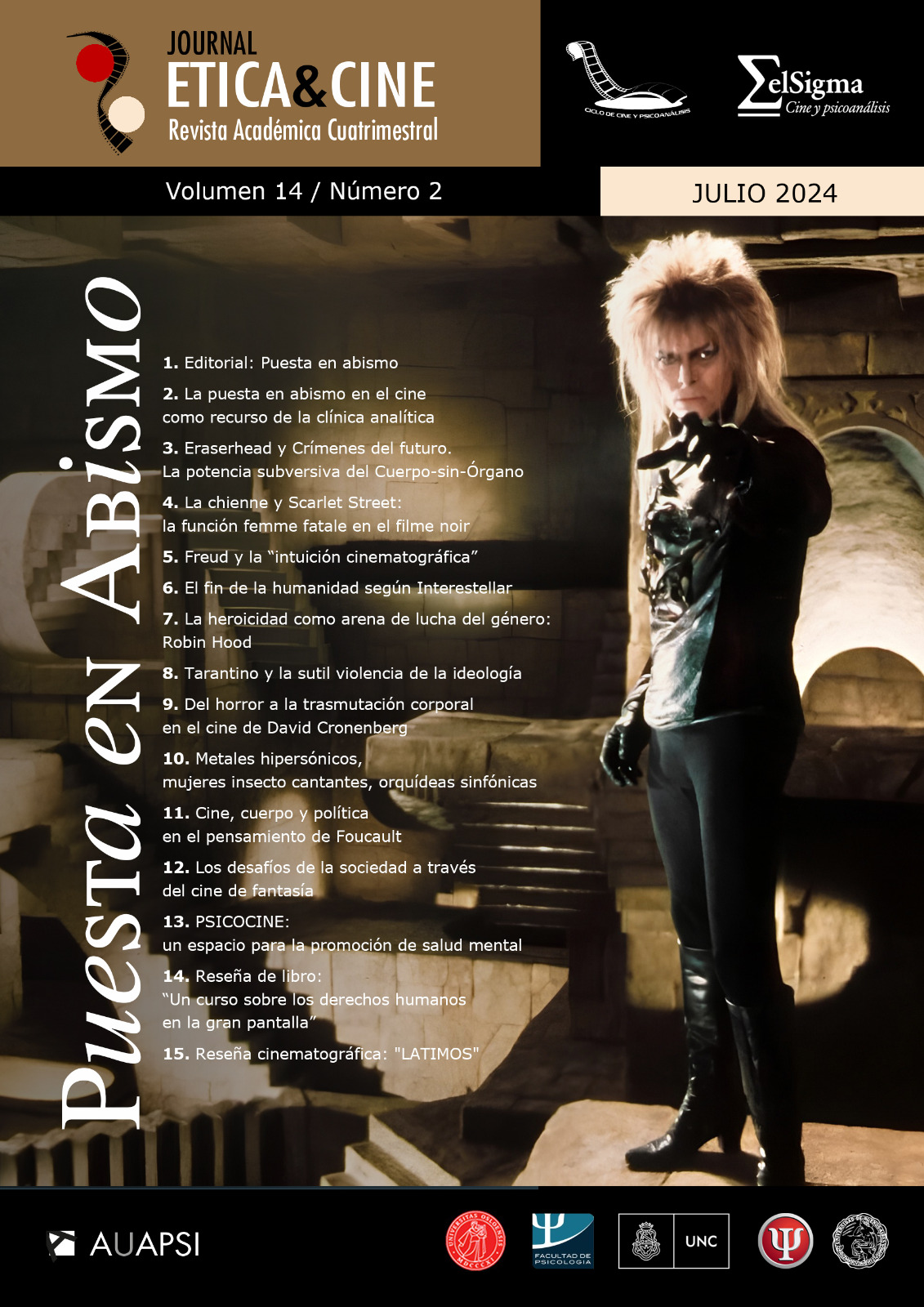Freud and “cinematic intuition”: psychoanalysis, cinema and epistemology
DOI:
https://doi.org/10.31056/2250.5415.v14.n2.45756Keywords:
Psychoanalysis, CinemaAbstract
On the basis of a brief historiographic analysis, this article examines the network of relations between psychoanalysis and cinema by using a new method of inquiry that crosses these “twin” spheres from an epistemological perspective. The approach consists of questioning the way in which psychoanalytic theory is put into play in response to the cinematographic apparatus. This means examining the syntagm “psychoanalysis and cinema” on the larger field of the study of the episteme in which it is inscribed: an episteme which implicitly makes cinema function within the psychoanalytic field just as it liberates it from its “auxiliary” status.
References
Alister, I., & Hauke, C. (2001). Jung & Film: Post-Jungian Takes on the Moving Image. Brunner/Routledge.
Arnoldy, É. (2002). French Cancan et le spectateur mobile. CiNéMAS, 12(3), 11-31.
Assoun, P.L. (2000). La Métapsychologie. PUF. Hay traducción al español: La metapsicología, México, Siglo XXI, 2002.
Bachelard, G. (1999). La Formation de l’esprit scientifique. Contribution à une psychanalyse de la connaissance [1938]. Librairie philosophique J. Vrin. Hay traducción al español: La formación del espíritu científico. Contribución a un psicoanálisis del conocimiento objetivo, México, Siglo XXI, 20a ed., 2000.
Baudry, J.L. (1993). L’Effet cinéma [1978]. Albatros.
Bergstrom, J. (Ed.). (1999). Endless Night: Cinema and Psychoanalysis, Parallel Histories. University of California Press.
Dhote, A. (Ed.). (1989). Cinéma et Psychanalyse. CinémAction, (50).
Doane, M.A. (1999). Temporality, Storage, Legibility: Freud, Marey and the Cinema. In J. Bergstrom (Ed.), Endless Night: Cinema and Psychoanalysis, Parallel Histories (pp. 57-87). University of California Press.
Doane, M.A. (2002). The Emergence of Cinematic Time: Modernity, Contingency, the Archive. Harvard University Press.
Freud, S. (1950). Entwurf Einer Psychologie [1895]. In M. Bonaparte, A. Freud, & E. Kris (Eds.), Aus den Anfange der Psychoanalyse (pp. 371-466). Imago Publishing Co.
Freud, S. (1971). L’Interprétation des rêves [1900]. PUF.
Freud, S. (1981). Notice sur le bloc magique [1925]. Revue française de psychanalyse, 45(5), 1107-1110.
Gabbard, G.O. (Ed.). (2000). Psychoanalysis and Film. Karnac.
Gabbard, K., & Gabbard, G.O. (1987). Psychiatry and The Cinema. American Psychiatric Press.
Gagnebin, M. (Ed.). (2001). Cinéma et Inconscient. Champ Vallon.
Green, A. (1972). De l’Esquisse à L’Interprétation des rêves: coupure et clôture. Nouvelle Revue de psychanalyse, (5), 155-180.
Jones, E. (1973). Essais de psychanalyse appliquée [1923]. Payot. Hay traducción al español: Ensayos de psicoanálisis aplicado. Ed. Tiempo Nuevo, Caracas, 1971.
Lavallée, G. (1999). L’Enveloppe visuelle du Moi. Perception et hallucination. Dunod. Hay traducción al español: La envoltura visual del Yo. Percepción alucinadora, Biblioteca Nueva, 2001.
Lebeau, V. (1995). Lost Angels: Psychoanalysis and Cinema. Routledge.
Metz, C. (1993). Le Signifiant imaginaire. Psychanalyse et Cinéma [1977]. Christian Bourgois. Hay traducción al español: El significante imaginario Psicoanálisis y cine, Barcelona, Paidós, 2001.
Ramain, P. (1926). Le cinéma, art du rêve, doit être psychanalytique. Le film, pour être cet art, doit se rapprocher de la musique. Ciné, (1), 4.
Ramain, P. (1926a). Le film peut traduire et créer le rêve. Cinéa-ciné pour tous, (67), 10-14.
Regosa, M. (Ed.). (2000). Lampi de felicità: cinema e psicoanalisi. Alinea.
Sabbadini, A. (Ed.). (2003). The Couch and the Silver Screen: Psychoanalytic Reflections on European Cinema. Brunner/Routledge.
Walker, J. (1993). Coaching Resistance: Women, Film and Psychoanalytic Psychiatry. University of Minnesota Press.
Downloads
Published
Issue
Section
License
Copyright (c) 2024 Ética y Cine Journal

This work is licensed under a Creative Commons Attribution-ShareAlike 4.0 International License.
Los autores que publiquen en Ética y Cine Journal aceptan las siguientes condiciones:
Los autores/as conservan los derechos de autor © y permiten la publicación a Ética y Cine Journal, bajo licencia CC BY-SA / Reconocimiento - Reconocimiento-CompartirIgual 4.0 Internacional. La adopción de esta licencia permite copiar, redistribuir, comunicar públicamente la obra, reconociendo los créditos de la misma, y construir sobre el material publicado, debiendo otorgar el crédito apropiado a través de un enlace a la licencia e indicando si se realizaron cambios.

Este obra está bajo una licencia de Creative Commons Reconocimiento-CompartirIgual 4.0 Internacional.




